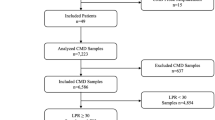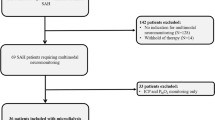Abstract
Background
This observational microdialysis (MD) study of 33 subarachnoid hemorrhage patients explores brain interstitial levels of glutamine, glutamate, lactate and pyruvate, and their relationship to clinical status and clinical course at the neurointensive care unit.
Methods
The focus was on ischemic events, defined by clinical criteria or by radiology, and the significance of brain interstitial glutamine levels and lactate/pyruvate (L/P) ratio.
Results
Eleven out of 12 periods with an ischemic MD pattern, defined as lactate/pyruvate (L/P) ratios exceeding 40, were either related to delayed ischemic neurological deficits (DIND) or CT-verified infarcts, confirming that L/P above 40 is a specific ischemic and pathological MD measure. Poor admittance WFNS grade (WFNS 4–5) patients had lower glutamine at the onset of monitoring than what good admittance WFNS grade (WFNS 1–3) patients had (P < 0.05). Interstitial glutamine increased over time in most patients. A “glutamine surge” was defined as a period where the interstitial glutamine concentration increased at least 150 μM over 12 h. Fifteen patients had a DIND and associated MD patterns were glutamine surges (n = 12) and/or L/P>40 (n = 6). Seven patients received vasospasm treatment; in five of these the only DIND-associated MD pattern was a glutamine surge. Seventy percent of the glutamine surges occurred during ongoing propofol sedation, and there was no association between extubations and glutamine surges. There was no difference in mean glutamine levels during the monitoring period between patients with favorable 6-month outcome and patients with poor 6-month outcome.
Conclusion
We suggest that an increasing interstitial glutamine trend is a dynamic sign of augmented astrocytic metabolism with accelerated glutamate uptake and glutamine synthesis. This pattern is presumably present in metabolically challenged, but yet not overt ischemic tissue.


Similar content being viewed by others
Abbreviations
- CPP:
-
cerebral perfusion pressure
- CSF:
-
cerebrospinal fluid
- CT:
-
computed tomography
- Gln:
-
glutamine
- Glt:
-
glutamate
- GMS:
-
Glasgow Motor Score
- GOS:
-
Glasgow Outcome Scale
- HPLC:
-
high performance liquid chromatography
- ICP:
-
intracranial pressure
- L/P:
-
lactate/pyruvate ratio
- MAP:
-
mean arterial pressure
- MD:
-
microdialysis
- NICU:
-
neurointensive care unit
- RLS:
-
Reaction Level Scale
- SAH:
-
subarachnoid hemorrhage
- SD:
-
standard deviation
- TBI:
-
traumatic brain injury
- TCA:
-
tricarboxylic acid
- VD:
-
ventricular drain
- WFNS:
-
World Federation of Neurological Surgeons
References
Borg J, Britton M, Colliander M, Ericson K af Geijerstam J, Marke L, Nathorst Westfelt J, Oredsson S, Ronne Engstrom E (2000) Hjärnskakning -övervakning på sjukhus eller datortomografi och hemgång, The Swedish Council on Technology Assesment in Health Care, Stockholm, p 26
Broer S, Brookes N (2001) Transfer of glutamine between astrocytes and neurons. J Neurochem 77:705–719. doi:10.1046/j.1471-4159.2001.00322.x
Cesarini KG, Enblad P, Ronne-Engstrom E, Marklund N, Salci K, Nilsson P, Hardemark HG, Hillered L, Persson L (2002) Early cerebral hyperglycolysis after subarachnoid haemorrhage correlates with favourable outcome. Acta Neurochir (Wien) 144:1121–1131. doi:10.1007/s00701-002-1011-9
Dohmen C, Bosche B, Graf R, Staub F, Kracht L, Sobesky J, Neveling M, Brinker G, Heiss WD (2003) Prediction of malignant course in MCA infarction by PET and microdialysis. Stroke 34:2152–2158. doi:10.1161/01.STR.0000083624.74929.32
Gorovits R, Avidan N, Avisar N, Shaked I, Vardimon L (1997) Glutamine synthetase protects against neuronal degeneration in injured retinal tissue. Proc Natl Acad Sci USA 94:7024–7029. doi:10.1073/pnas.94.13.7024
Hamann M, Rossi DJ, Marie H, Attwell D (2002) Knocking out the glial glutamate transporter GLT-1 reduces glutamate uptake but does not affect hippocampal glutamate dynamics in early simulated ischaemia. Eur J Neurosci 15:308–314. doi:10.1046/j.0953-816x.2001.01861.x
Hamberger AC, Chiang GH, Nylen ES, Scheff SW, Cotman CW (1979) Glutamate as a CNS transmitter. I. Evaluation of glucose and glutamine as precursors for the synthesis of preferentially released glutamate. Brain Res 168:513–530. doi:10.1016/0006-8993(79)90306-8
Hillered L, Hallstrom A, Segersvard S, Persson L, Ungerstedt U (1989) Dynamics of extracellular metabolites in the striatum after middle cerebral artery occlusion in the rat monitored by intracerebral microdialysis. J Cereb Blood Flow Metab 9:607–616
Hillered L, Persson L, Nilsson P, Ronne-Engstrom E, Enblad P (2006) Continuous monitoring of cerebral metabolism in traumatic brain injury: a focus on cerebral microdialysis. Curr Opin Crit Care 12:112–118. doi:10.1097/01.ccx.0000216576.11439.df
Hillered L, Persson L, Ponten U, Ungerstedt U (1990) Neurometabolic monitoring of the ischaemic human brain using microdialysis. Acta Neurochir (Wien) 102:91–97. doi:10.1007/BF01405420
Hillered L, Vespa PM, Hovda DA (2005) Translational neurochemical research in acute human brain injury: the current status and potential future for cerebral microdialysis. J Neurotrauma 22:3–41. doi:10.1089/neu.2005.22.3
Hlatky R, Valadka AB, Goodman JC, Robertson CS (2004) Evolution of brain tissue injury after evacuation of acute traumatic subdural hematomas. Neurosurgery 55:1318–1323, discussion 1324. doi:10.1227/01.NEU.0000143029.42638.2C
Jennett B, Bond M (1975) Assessment of outcome after severe brain damage. Lancet 1:480–484. doi:10.1016/S0140-6736(75)92830-5
Johnston AJ, Gupta AK (2002) Advanced monitoring in the neurology intensive care unit: microdialysis. Curr Opin Crit Care 8:121–127. doi:10.1097/00075198-200204000-00006
Kanamori K, Ross BD (2004) Quantitative determination of extracellular glutamine concentration in rat brain, and its elevation in vivo by system A transport inhibitor, alpha-(methylamino)isobutyrate. J Neurochem 90:203–210. doi:10.1111/j.1471-4159.2004.02478.x
Kanamori K, Ross BD, Kondrat RW (2002) Glial uptake of neurotransmitter glutamate from the extracellular fluid studied in vivo by microdialysis and (13)C NMR. J Neurochem 83:682–695. doi:10.1046/j.1471-4159.2002.01161.x
Koura SS, Doppenberg EM, Marmarou A, Choi S, Young HF, Bullock R (1998) Relationship between excitatory amino acid release and outcome after severe human head injury. Acta Neurochir Suppl (Wien) 71:244–246
Magistretti PJ, Pellerin L (1999) Astrocytes couple synaptic activity to glucose utilization in the brain. News Physiol Sci 14:177–182
Magistretti PJ, Pellerin L, Rothman DL, Shulman RG (1999) Energy on demand. Science 283:496–497. doi:10.1126/science.283.5401.496
Meyerson BA, Linderoth B, Karlsson H, Ungerstedt U (1990) Microdialysis in the human brain: extracellular measurements in the thalamus of parkinsonian patients. Life Sci 46:301–308. doi:10.1016/0024-3205(90)90037-R
Mitani A, Tanaka K (2003) Functional changes of glial glutamate transporter GLT-1 during ischemia: an in vivo study in the hippocampal CA1 of normal mice and mutant mice lacking GLT-1. J Neurosci 23:7176–7182
Nelson DW, Bellander BM, Maccallum RM, Axelsson J, Alm M, Wallin M, Weitzberg E, Rudehill A (2004) Cerebral microdialysis of patients with severe traumatic brain injury exhibits highly individualistic patterns as visualized by cluster analysis with self-organizing maps. Crit Care Med 32:2428–2436. doi:10.1097/01.CCM.0000147688.08813.9C
Nishizawa Y (2001) Glutamate release and neuronal damage in ischemia. Life Sci 69:369–381. doi:10.1016/S0024-3205(01)01142-0
Peerdeman SM, van Tulder MW, Vandertop WP (2003) Cerebral microdialysis as a monitoring method in subarachnoid hemorrhage patients, and correlation with clinical events–a systematic review. J Neurol 250:797–805. doi:10.1007/s00415-003-1079-z
Ramonet D, Rodriguez MJ, Fredriksson K, Bernal F, Mahy N (2004) In vivo neuroprotective adaptation of the glutamate/glutamine cycle to neuronal death. Hippocampus 14:586–594. doi:10.1002/hipo.10188
Richards DA, Tolias CM, Sgouros S, Bowery NG (2003) Extracellular glutamine to glutamate ratio may predict outcome in the injured brain: a clinical microdialysis study in children. Pharmacol Res 48:101–109
Ronne Engstrom E, Hillered L, Enblad P, Karlsson T (2005) Cerebral interstitial levels of glutamate and glutamine after intravenous administration of nutritional amino acids in neurointensive care patients. Neurosci Lett 384:7–10. doi:10.1016/j.neulet.2005.04.030
Ronne-Engstrom E, Cesarini KG, Enblad P, Hesselager G, Marklund N, Nilsson P, Salci K, Persson L, Hillered L (2001) Intracerebral microdialysis in neurointensive care: the use of urea as an endogenous reference compound. J Neurosurg 94:397–402
Sakowitz OW, Unterberg AW (2006) Detecting and treating microvascular ischemia after subarachnoid hemorrhage. Curr Opin Crit Care 12:103–111. doi:10.1097/01.ccx.0000216575.03815.ee
Samuelsson C, Hillered L, Zetterling M, Enblad P, Hesselager G, Ryttlefors M, Kumlien E, Lewen A, Marklund N, Nilsson P, Salci K, Ronne-Engstrom E (2007) Cerebral glutamine and glutamate levels in relation to compromised energy metabolism: a microdialysis study in subarachnoid hemorrhage patients. J Cereb Blood Flow Metab 27:1309–1317. doi:10.1038/sj.jcbfm.9600433
Samuelsson C, Howells T, Kumlien E, Enblad P, Hillered L, Ronne-Engstrom E Relationship between intracranial hemodynamics and microdialysis markers of energy metabolism and glutamate-glutamine turnover in subarachnoid hemorrhage patients. J Neurosurg (in press)
Sarrafzadeh A, Haux D, Kuchler I, Lanksch WR, Unterberg AW (2004) Poor-grade aneurysmal subarachnoid hemorrhage: relationship of cerebral metabolism to outcome. J Neurosurg 100:400–406
Sarrafzadeh A, Haux D, Sakowitz O, Benndorf G, Herzog H, Kuechler I, Unterberg A (2003) Acute focal neurological deficits in aneurysmal subarachnoid hemorrhage: relation of clinical course, CT findings, and metabolite abnormalities monitored with bedside microdialysis. Stroke 34:1382–1388. doi:10.1161/01.STR.0000074036.97859.02
Sarrafzadeh AS, Sakowitz OW, Kiening KL, Benndorf G, Lanksch WR, Unterberg AW (2002) Bedside microdialysis: a tool to monitor cerebral metabolism in subarachnoid hemorrhage patients? Crit Care Med 30:1062–1070. doi:10.1097/00003246-200205000-00018
Seki Y, Feustel PJ, Keller RW Jr, Tranmer BI, Kimelberg HK (1999) Inhibition of ischemia-induced glutamate release in rat striatum by dihydrokinate and an anion channel blocker. Stroke 30:433–440
Skjoth-Rasmussen J, Schulz M, Kristensen SR, Bjerre P (2004) Delayed neurological deficits detected by an ischemic pattern in the extracellular cerebral metabolites in patients with aneurysmal subarachnoid hemorrhage. J Neurosurg 100:8–15
Stalhammar D, Starmark JE, Holmgren E, Eriksson N, Nordstrom CH, Fedders O, Rosander B (1988) Assessment of responsiveness in acute cerebral disorders. A multicentre study on the reaction level scale (RLS 85). Acta Neurochir (Wien) 90:73–80. doi:10.1007/BF01560558
Suarez I, Bodega G, Fernandez B (2002) Glutamine synthetase in brain: effect of ammonia. Neurochem Int 41:123–142. doi:10.1016/S0197-0186(02)00033-5
Szatkowski M, Barbour B, Attwell D (1990) Non-vesicular release of glutamate from glial cells by reversed electrogenic glutamate uptake. Nature 348:443–446. doi:10.1038/348443a0
Teasdale G, Jennett B (1976) Assessment and prognosis of coma after head injury. Acta Neurochir (Wien) 34:45–55. doi:10.1007/BF01405862
Teasdale GM, Drake CG, Hunt W, Kassell N, Sano K, Pertuiset B, De Villiers JC (1988) A universal subarachnoid hemorrhage scale: report of a committee of the World Federation of Neurosurgical Societies. J Neurol Neurosurg Psychiatry 51:1457. doi:10.1136/jnnp.51.11.1457
Thanki CM, Sugden D, Thomas AJ, Bradford HF (1983) In vivo release from cerebral cortex of [14C]glutamate synthesized from [U-14C]glutamine. J Neurochem 41:611–617. doi:10.1111/j.1471-4159.1983.tb04785.x
Vespa P, Bergsneider M, Hattori N, Wu HM, Huang SC, Martin NA, Glenn TC, McArthur DL, Hovda DA (2005) Metabolic crisis without brain ischemia is common after traumatic brain injury: a combined microdialysis and positron emission tomography study. J Cereb Blood Flow Metab 25:763–774. doi:10.1038/sj.jcbfm.9600073
Xie M, Wang W, Kimelberg HK, Zhou M (2007) Oxygen and glucose deprivation-induced changes in astrocyte membrane potential and their underlying mechanisms in acute rat hippocampal slices. J Cereb Blood Flow Metab
Xu GY, McAdoo DJ, Hughes MG, Robak G, de Castro R Jr (1998) Considerations in the determination by microdialysis of resting extracellular amino acid concentrations and release upon spinal cord injury. Neuroscience 86:1011–1021. doi:10.1016/S0306-4522(98)00063-3
Yi JH, Hazell AS (2006) Excitotoxic mechanisms and the role of astrocytic glutamate transporters in traumatic brain injury. Neurochem Int 48:394–403. doi:10.1016/j.neuint.2005.12.001
Acknowledgements
We are grateful to Inger Ståhl-Myllyaho for her expert work with the HPLC system and to the staff at the neurointensive care unit for care of the patients and collection of the MD samples.
Financial support has been obtained from the following contributors: Swedish Medical Research Council, grants 521–2004–6210 and 521–2007–3254, GlaxoSmithKline, the Margarethahemmet Foundation, the Erland Wessler Foundation, The Ahlén Foundation, the Selanders Foundation and Uppsala University Hospital.
Author information
Authors and Affiliations
Corresponding author
Additional information
Comment
This paper addresses the field of neurochemistry that has not yet been fully understood. The paper is interesting, although the lactate/pyruvate ratio (L/P) has been addressed in multiple papers. The attempt to correlate L/P to clinical events, i.e., delayed ischemic neurological deficits (DIND), has been addressed in a few papers only, and yet there is no work using microdialysis patterns in an attempt to progressively forecast the ischemic events, which could bring microdialysis research further.
Overall, I find this paper well written and interesting, addressing in a very honest way the difficult field of cerebral metabolism in patients with aneurismal subarachnoid hemorrhage and delayed neurological deficits.
Jane Skjoth-Rasmussen
Rigshospitalet, Copenhagen
Rights and permissions
About this article
Cite this article
Samuelsson, C., Hillered, L., Enblad, P. et al. Microdialysis patterns in subarachnoid hemorrhage patients with focus on ischemic events and brain interstitial glutamine levels. Acta Neurochir 151, 437–446 (2009). https://doi.org/10.1007/s00701-009-0265-x
Received:
Accepted:
Published:
Issue Date:
DOI: https://doi.org/10.1007/s00701-009-0265-x




